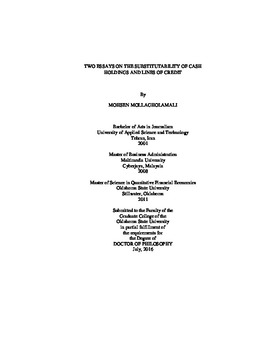| dc.contributor.advisor | Rao, Ramesh P. | |
| dc.contributor.author | Mollagholamali, Mohsen | |
| dc.date.accessioned | 2017-02-22T22:10:12Z | |
| dc.date.available | 2017-02-22T22:10:12Z | |
| dc.date.issued | 2016-07 | |
| dc.identifier.uri | https://hdl.handle.net/11244/48848 | |
| dc.description.abstract | Essay 1: using a novel database of lines of credit from 42 countries, I study the choice between cash holdings and lines of credit in the liquidity management of the firm and examine the determinants of this choice in the international setting. The focus of this essay is to show the influence of country level variables on this choice and I find that the level of competition in the banking industry, shareholder rights, creditor rights, and rule of law have significant and positive effect on the likelihood of obtaining and utilization of lines of credit. Even when I include all these country level variables together in my model, I still find significant relationships between banking competition and rule of law on the utilization of lines of credit. Furthermore, when I aggregate all the country level governance variables, I find that both banking competition and country governance index are positively and significantly related to the likelihood of obtaining and also utilizing lines of credit in the liquidity management of the firm. The results of the main tests of the study are still robust using several different sub-samples. | |
| dc.description.abstract | Essay 2: most of the studies of the choice between cash holdings and lines of credit examine how managers make this choice. My goal in this essay is to look at this choice from the point of view of shareholders and the value they place on each of these liquidity sources. The results of this essay supports the weak substitutability of cash holdings and lines of credit. My base model shows that shareholders place a positive and significant value on lines of credit, but they still place a higher value on cash holdings. I find that both cash and lines of credit are valued significantly higher among the constrained firms as opposed to unconstrained firms which suggests that the shareholders of constrained firms appreciate any type of liquidity that they can utilize. I also show that shareholders of poorly governed firms place a higher value on lines of credit as opposed to cash. When I use an aggregate measure of growth opportunities, I show that high growth firms place a higher value on both cash holdings and lines of credit. Finally, I show that shareholders place a lower value on lines of credit during the crisis as opposed to normal times. This is consistent with the findings of Sufi (2009) which suggest that the strength and consistency of cash flow are crucial on the decision to utilize cash flows. | |
| dc.format | application/pdf | |
| dc.language | en_US | |
| dc.rights | Copyright is held by the author who has granted the Oklahoma State University Library the non-exclusive right to share this material in its institutional repository. Contact Digital Library Services at lib-dls@okstate.edu or 405-744-9161 for the permission policy on the use, reproduction or distribution of this material. | |
| dc.title | Two essays on the substitutability of cash holdings and lines of credit | |
| dc.contributor.committeeMember | Nejadmalayeri, Ali | |
| dc.contributor.committeeMember | Zhang, Jun | |
| dc.contributor.committeeMember | Adkins, Lee | |
| osu.filename | Mollagholamali_okstate_0664D_14792.pdf | |
| osu.accesstype | Open Access | |
| dc.type.genre | Dissertation | |
| dc.type.material | Text | |
| thesis.degree.discipline | Business Administration | |
| thesis.degree.grantor | Oklahoma State University | |
